Understanding the Spatial Differentiation and Driving Mechanisms of Human Settlement Satisfaction Using Geographically Explainable Machine Learning: A Case Study of Xiamen’s Urban Physical Examination
Abstract
1. Introduction
2. Data and Methods
2.1. Study Area
2.2. Data
- (1)
- Block Scale
- (2)
- Community Scale
- (3)
- Housing Scale
- (4)
- Personal Characteristics
2.3. Methods
2.3.1. Random Forest Model
2.3.2. Geographical Random Forest Model
3. Result and Discussion
3.1. Spatial Distribution of HSS
3.2. The Relationship Between HSS and Influencing Factors
3.3. Spatial Heterogeneity of Factors Influencing HSS
3.3.1. Spatial Variation in the Model’s Goodness-of-Fit
3.3.2. Spatial Distribution of the Dominant Factors
3.3.3. Spatial Variation in Local Feature Importance
- (1)
- Block Scale
- (2)
- Community Scale
- (3)
- Housing Scale
- (4)
- Personal Characteristics
4. Conclusions
Author Contributions
Funding
Data Availability Statement
Acknowledgments
Conflicts of Interest
References
- Chen, H.; Wang, X.; Guo, Z. Transformation of Urban Planning: Thoughts on Incremental Planning, Stock-Based Planning, and Reduction Planning. China City Plan. Rev. 2016, 25, 26. [Google Scholar]
- Pan, W.; Du, J. Towards Sustainable Urban Transition: A Critical Review of Strategies and Policies of Urban Village Renewal in Shenzhen, China. Land Use Policy 2021, 111, 105744. [Google Scholar] [CrossRef]
- Zhan, D.; Kwan, M.-P.; Zhang, W.; Fan, J.; Yu, J.; Dang, Y. Assessment and Determinants of Satisfaction with Urban Livability in China. Cities 2018, 79, 92–101. [Google Scholar] [CrossRef]
- Zhang, L.; Zhang, R.; Yin, B. The Impact of the Built-up Environment of Streets on Pedestrian Activities in the Historical Area. Alex. Eng. J. 2021, 60, 285–300. [Google Scholar] [CrossRef]
- Chao, H.; Kong, H. Changes in Family Structure during Shantytown Redevelopment and Their Correlation with the Living Space. Land 2024, 13, 1025. [Google Scholar] [CrossRef]
- Chao, H.; Ma, X.; Wang, Y.; Kong, H. Changes of School Travel during Shantytown Redevelopment: Evidence from Heze, China. Ann. Am. Assoc. Geogr. 2025, 115, 2071–2094. [Google Scholar] [CrossRef]
- Ahmed, N.O.; El-Halafawy, A.M.; Amin, A.M. A Critical Review of Urban Livability. Eur. J. Sustain. Dev. 2019, 8, 165. [Google Scholar] [CrossRef]
- Kashef, M. Urban Livability across Disciplinary and Professional Boundaries. Front. Archit. Res. 2016, 5, 239–253. [Google Scholar] [CrossRef]
- Samavati, S.; Veenhoven, R. Happiness in Urban Environments: What We Know and Don’t Know yet. J. Hous. Built Environ. 2024, 39, 1649–1707. [Google Scholar] [CrossRef]
- Li, X.; Liu, H. The Influence of Subjective and Objective Characteristics of Urban Human Settlements on Residents’ Life Satisfaction in China. Land 2021, 10, 1400. [Google Scholar] [CrossRef]
- Liu, Z.; Kemperman, A.; Timmermans, H. Social-Ecological Correlates of Older Adults’ Outdoor Activity Patterns. J. Transp. Health 2020, 16, 100840. [Google Scholar] [CrossRef]
- Cen, L.; Xiao, Y. Assessing Urban Park Accessibility via Population Projections: Planning for Green Equity in Shanghai. Land 2025, 14, 1580. [Google Scholar] [CrossRef]
- Zhan, D.; Wang, Z.; Zhang, W.; Dang, X.; Zhou, J. Impact of multi-scale perceptions of urban human settlements on residents’ subjective well-being: Based on the “four good” construction concept and city health examination data. City Plan. 2025, 45, 4–15+110. Available online: http://www.planning.com.cn/WKE/WebPublication/paperDigest.aspx?paperID=2f02abf5-239a-443f-b7b7-0ff870b77dc2 (accessed on 22 October 2025). (In Chinese).
- Means, R.; Richards, S.; Smith, R. Community Care: Policy and Practice; Bloomsbury Publishing: London, UK, 2008. [Google Scholar]
- Bowles, S.; Gintis, H. Social Capital and Community Governance. Econ. J. 2002, 112, F419–F436. [Google Scholar] [CrossRef]
- Zhang, F.; Zhang, C.; Hudson, J. Housing Conditions and Life Satisfaction in Urban China. Cities 2018, 81, 35–44. [Google Scholar] [CrossRef]
- Sun, R.; Li, W.; He, H.; Leng, S.; Cheng, J.; Yang, X.; Yu, Z.; Chen, L. Declining Subjective Well-Being Disparities Concurrent with Urbanization in China. Natl. Sci. Rev. 2025, 12, nwaf362. [Google Scholar] [CrossRef]
- Liu, Z.; Kemperman, A.; Timmermans, H.; Yang, D. Heterogeneity in Physical Activity Participation of Older Adults: A Latent Class Analysis. J. Transp. Geogr. 2021, 92, 102999. [Google Scholar] [CrossRef]
- MOHURD. Promote the High-Quality Development of Housing and Urban-Rural Construction with Full Efforts to Contribute to Achieving the Great Victory of Building a Moderately Prosperous Society in All Respects and Realizing the First Centenary Goal-The National Housing and Urban-Rural Construction Work Conference Was Held. Available online: https://www.mohurd.gov.cn/xinwen/jsyw/art/2019/art_303_243195.html (accessed on 22 October 2025). (In Chinese)
- MOHURD. Guidance from the Ministry of Housing and Urban-Rural Development on Comprehensively Carrying out Urban Health Examination Work. Available online: https://www.gov.cn/zhengce/zhengceku/202312/content_6918801.htm (accessed on 22 October 2025). (In Chinese)
- Zhang, W.; Cao, J.; He, J.; Chen, L. City Health Examination in China: A Methodology and Empirical Study. Chin. Geogr. Sci. 2021, 31, 951–965. [Google Scholar] [CrossRef]
- He, H.; Ren, Y.; Shen, L.; Xiao, J.; Lai, Y.; Yang, Y.; Zhang, L. A Guiding Methodology for “Urban Physical Examination”: Indicator Checklist, Benchmark Setting and Empirical Study. Sustain. Cities Soc. 2023, 98, 104835. [Google Scholar] [CrossRef]
- Chen, W.; Wang, Y.; Ren, Y.; Yan, H.; Shen, C. A Novel Methodology (WM-TCM) for Urban Health Examination: A Case Study of Wuhan in China. Ecol. Indic. 2022, 136, 108602. [Google Scholar] [CrossRef]
- Zhan, D.; Kwan, M.-P.; Zhang, W.; Chen, L.; Dang, Y. The Impact of Housing Pressure on Subjective Well-Being in Urban China. Habitat Int. 2022, 127, 102639. [Google Scholar] [CrossRef]
- Xiamen HURDB. Notice of Xiamen Municipal Housing and Construction Bureau on Issuing the 2025 Xiamen Urban Physical Examination Work Plan. Available online: https://szjj.xm.gov.cn/zwgk/tzgg/202506/t20250604_2937046.htm (accessed on 22 October 2025). (In Chinese)
- Xiamen GOMPG. Notice of the General Office of the Xiamen Municipal People’s Government on Issuing the Work Plan for Urban Physical Examination and Evaluation Under the Territorial Spatial Planning Framework. Available online: https://www.xm.gov.cn/zwgk/flfg/sfbwj/202303/t20230306_2723190.htm (accessed on 22 October 2025). (In Chinese)
- Xiamen GOMPG. Notice of the General Office of the Xiamen Municipal People’s Government on Issuing the Guiding Opinions for Implementing Urban Renewal Actions. Available online: https://www.xm.gov.cn/zwgk/flfg/sfbwj/202209/t20220930_2692084.htm (accessed on 22 October 2025). (In Chinese)
- Jiang, Y.; Sun, S.; Zheng, S. Exploring Urban Expansion and Socioeconomic Vitality Using NPP-VIIRS Data in Xia-Zhang-Quan, China. Sustainability 2019, 11, 1739. [Google Scholar] [CrossRef]
- Georganos, S.; Grippa, T.; Niang Gadiaga, A.; Linard, C.; Lennert, M.; Vanhuysse, S.; Mboga, N.; Wolff, E.; Kalogirou, S. Geographical Random Forests: A Spatial Extension of the Random Forest Algorithm to Address Spatial Heterogeneity in Remote Sensing and Population Modelling. Geocarto Int. 2021, 36, 121–136. [Google Scholar] [CrossRef]
- Li, A.; Zhang, Z.; Hong, Z.; Liu, L.; Liu, L.; Ashraf, T.; Liu, Y. Spatial Suitability Evaluation Based on Multisource Data and Random Forest Algorithm: A Case Study of Yulin, China. Front. Environ. Sci. 2024, 12, 1338931. [Google Scholar] [CrossRef]
- Tang, L.; Zhao, Y.; Yin, K.; Zhao, J. Xiamen. Cities 2013, 31, 615–624. [Google Scholar] [CrossRef]
- Li, X.; Lin, T.; Zhang, G.; Xiao, L.; Zhao, Q.; Cui, S. Dynamic Analysis of Urban Spatial Expansion and Its Determinants in Xiamen Island. J. Geogr. Sci. 2011, 21, 503–520. [Google Scholar] [CrossRef]
- Fasano, G.; Franceschini, A. A Multidimensional Version of the Kolmogorov–Smirnov Test. Mon. Not. R. Astron. Soc. 1987, 225, 155–170. [Google Scholar] [CrossRef]
- Gao, J. How does family socioeconomic status influence college students’ employment risk: The mediating effects of parental involvement and academic achievement. Nankai Econ. Res. 2022, 7, 162–181. [Google Scholar] [CrossRef]
- Cutler, D.R.; Edwards, T.C.; Beard, K.H.; Cutler, A.; Hess, K.T.; Gibson, J.; Lawler, J.J. Random Forests for Classification in Ecology. Ecology 2007, 88, 2783–2792. [Google Scholar] [CrossRef] [PubMed]
- Breiman, L. Random Forest. Mach. Learn. 2001, 45, 5–32. [Google Scholar] [CrossRef]
- Liaw, A.; Wiener, M. Classification and Regression by randomForest. R News 2002, 2, 18–22. [Google Scholar]
- Hengl, T.; Nussbaum, M.; Wright, M.N.; Heuvelink, G.B.; Gräler, B. Random Forest as a Generic Framework for Predictive Modeling of Spatial and Spatio-Temporal Variables. PeerJ 2018, 6, e5518. [Google Scholar] [CrossRef] [PubMed]
- Chao, H.; Xu, M.; Jin, S.T.; Kong, H. Understanding Temporary Residential Mobility during Urban Renewal: Insights from a Structured Community Survey and Machine Learning Analysis. Appl. Geogr. 2024, 172, 103425. [Google Scholar] [CrossRef]
- Athey, S.; Tibshirani, J.; Wager, S. Generalized Random Forests. Ann. Statist. 2019, 47, 1148–1178. [Google Scholar] [CrossRef]
- Wager, S.; Athey, S. Estimation and Inference of Heterogeneous Treatment Effects Using Random Forests. J. Am. Stat. Assoc. 2018, 113, 1228–1242. [Google Scholar] [CrossRef]
- Luo, Y.; Yan, J.; McClure, S. Distribution of the Environmental and Socioeconomic Risk Factors on COVID-19 Death Rate across Continental USA: A Spatial Nonlinear Analysis. Environ. Sci. Pollut. Res. 2021, 28, 6587–6599. [Google Scholar] [CrossRef]
- Zhao, H.; Liu, Y.; Yue, L.; Gu, T.; Tang, J.; Wang, Z. Unraveling the Factors behind Self-Reported Trapped Incidents in the Extraordinary Urban Flood Disaster: A Case Study of Zhengzhou City, China. Cities 2024, 155, 105444. [Google Scholar] [CrossRef]
- Anselin, L. Spatial Econometrics: Methods and Models; Kluwer Academic Publishers: Boston, MA, USA, 1988; Volume 2, pp. 283–291. [Google Scholar]
- Molnar, C. Interpretable Machine Learning; Lulu.com: Morrisville, NC, USA, 2020. [Google Scholar]
- Grömping, U. Variable Importance Assessment in Regression: Linear Regression versus Random Forest. Am. Stat. 2009, 63, 308–319. [Google Scholar] [CrossRef]
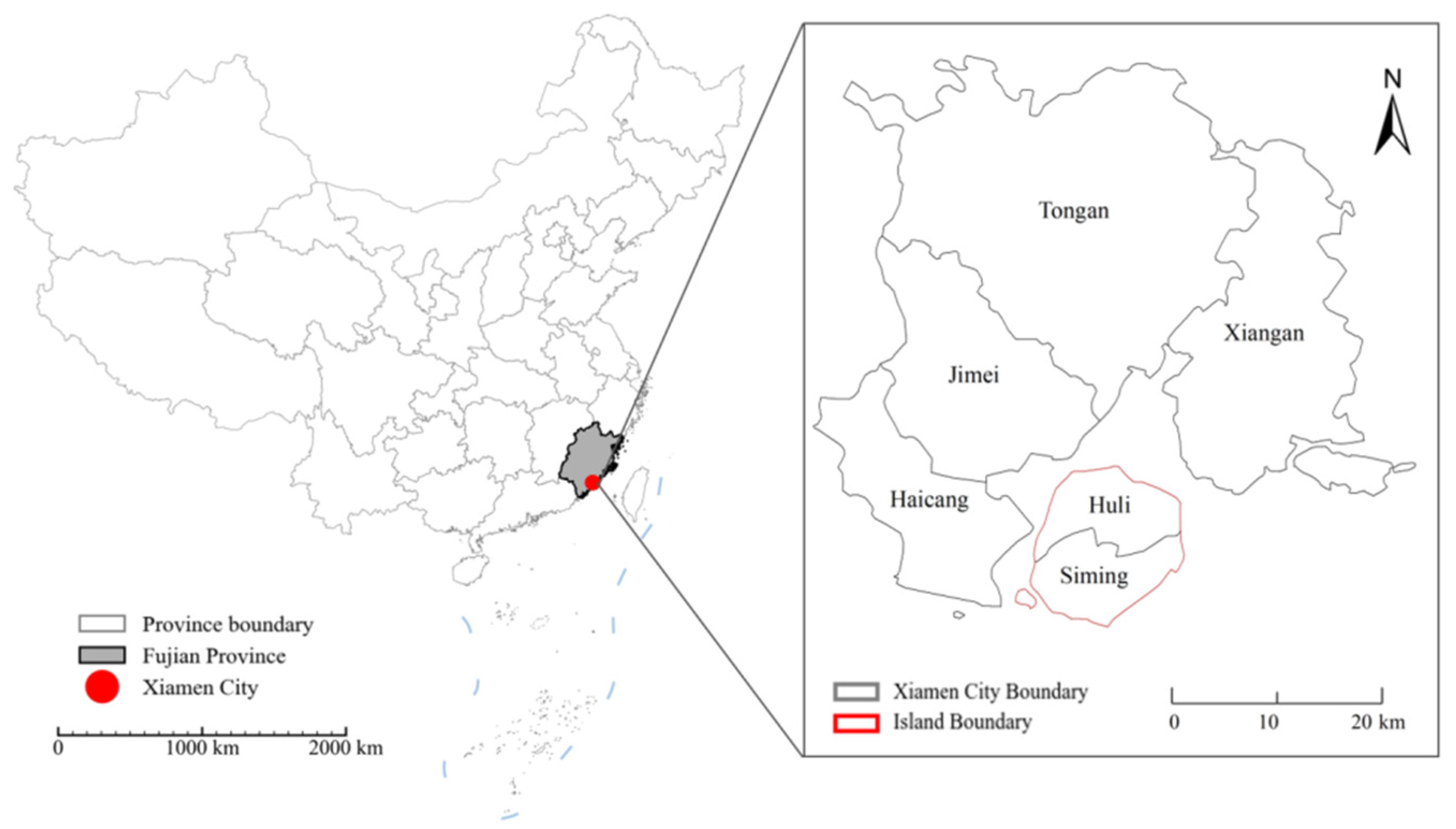

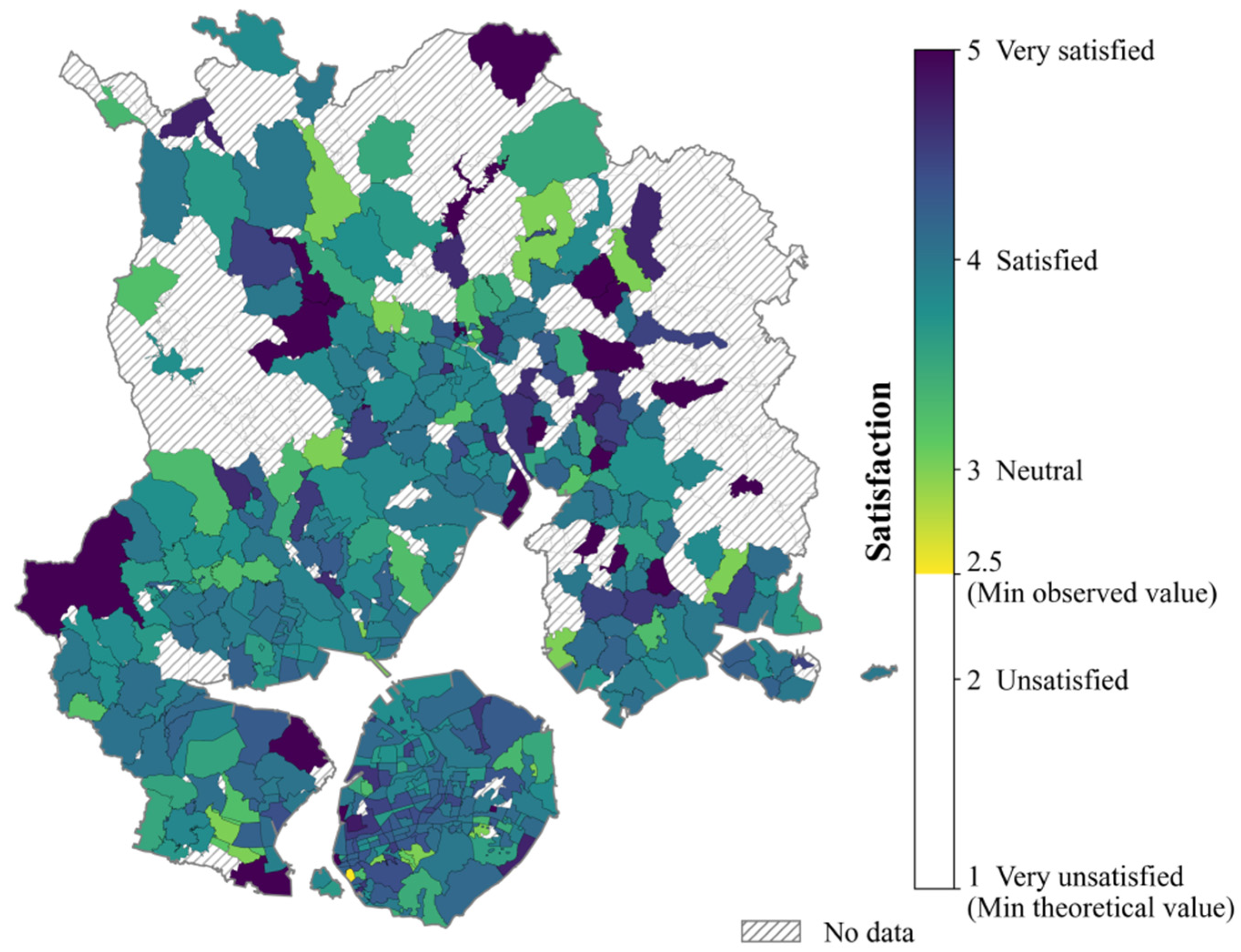



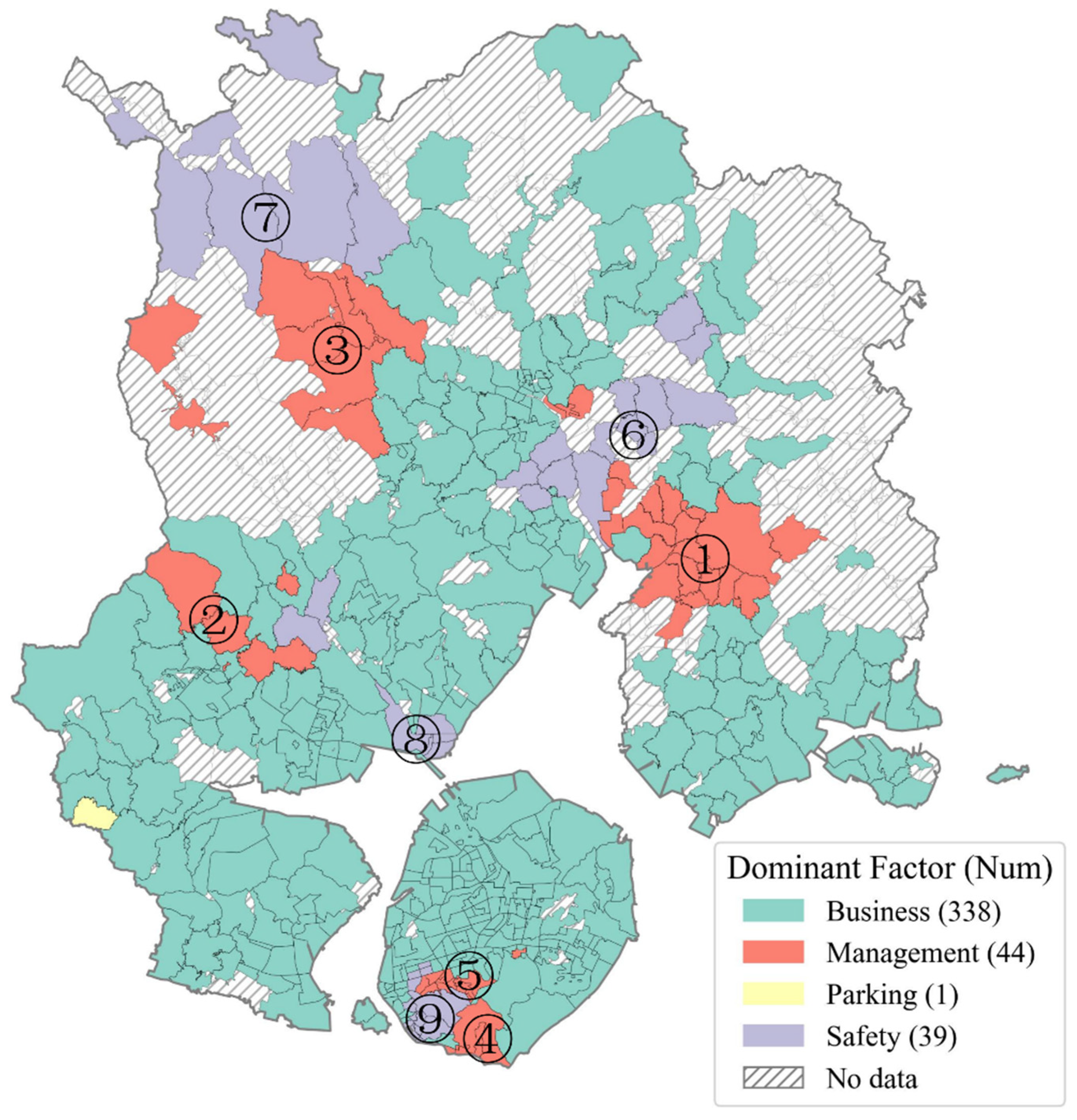

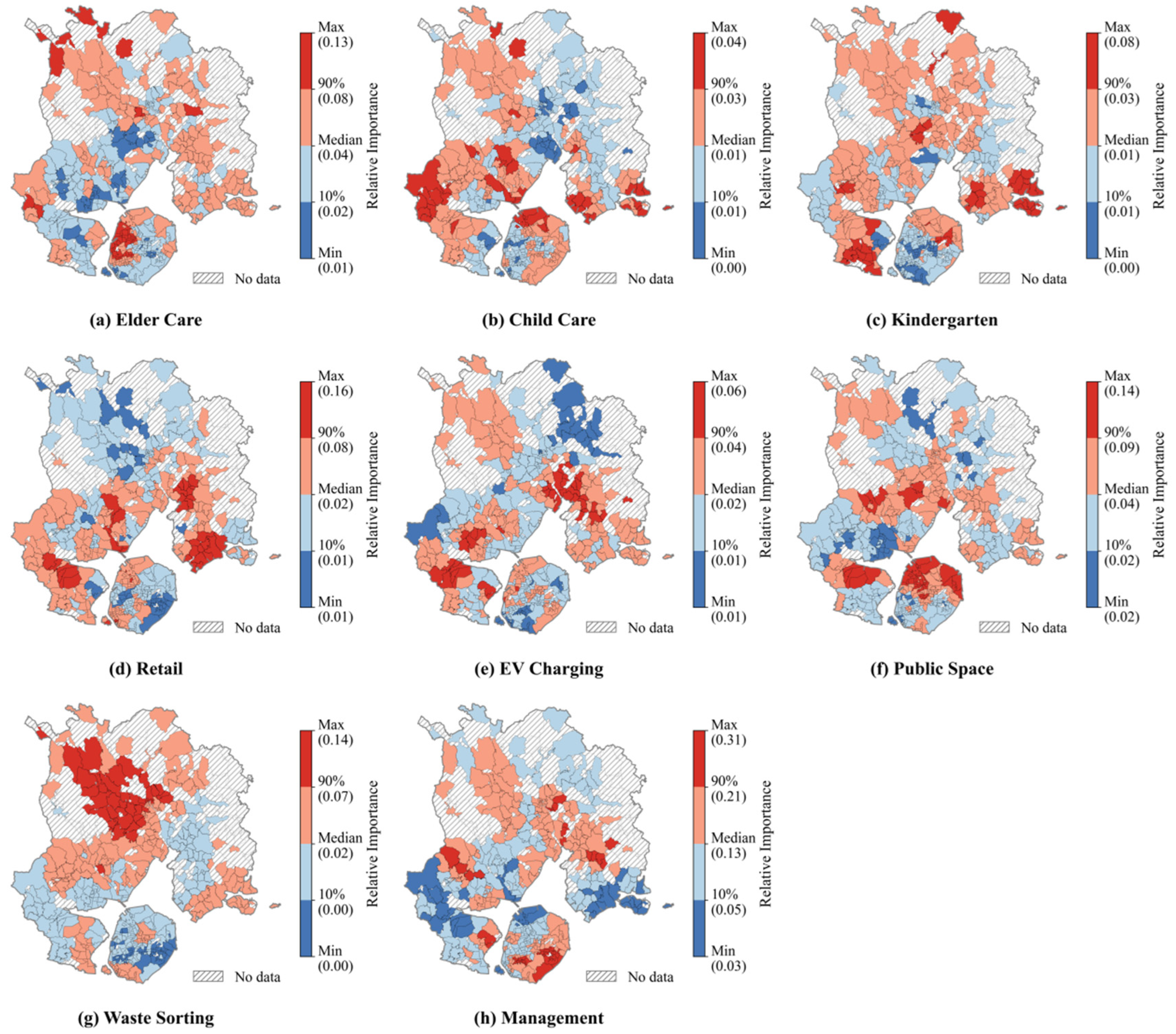

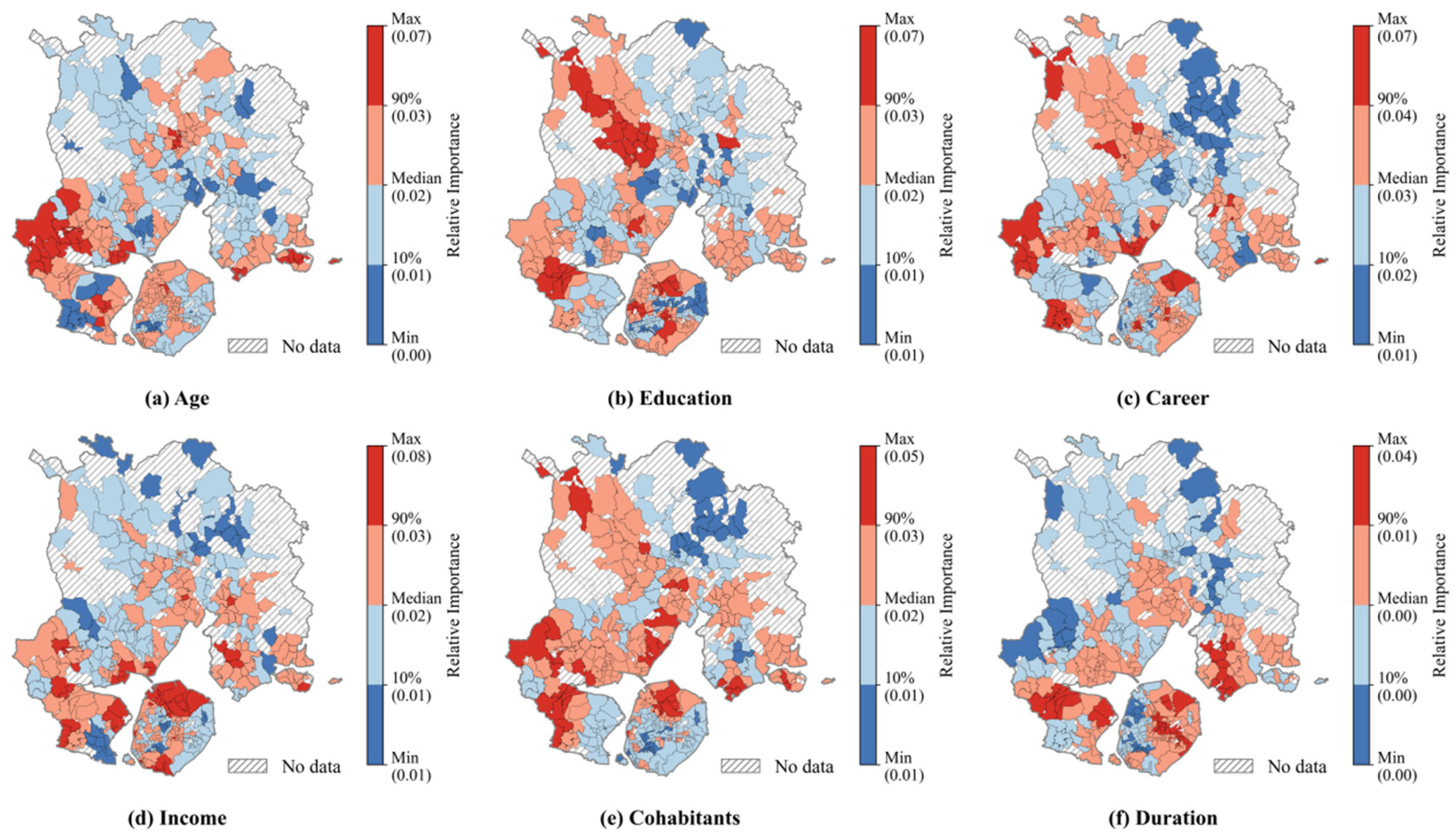
| Variable | Description | Mean | Std | Min | Max |
|---|---|---|---|---|---|
| Explained Variables | |||||
| Satisfaction | Composite satisfaction score | 3.972 | 0.863 | 1 | 5 |
| Explanatory Variables | |||||
| Block Scale | |||||
| Cultural | Perceived severity of cultural facilities issues | 0.081 | 0.087 | 0.000 | 0.500 |
| Park | Perceived severity of park facilities issues | 0.061 | 0.078 | 0.000 | 0.500 |
| Parking | Perceived severity of Parking issues | 0.135 | 0.119 | 0.000 | 0.500 |
| Business | Perceived level of business vitality | 0.346 | 0.094 | 0.100 | 0.500 |
| Community Scale | |||||
| Elder_Care | Perceived severity of elderly care issues | 0.107 | 0.150 | 0.000 | 0.700 |
| Child_Care | Perceived severity of child care issues | 0.067 | 0.094 | 0.000 | 0.500 |
| Kindergarten | Perceived severity of kindergarten issues | 0.042 | 0.077 | 0.000 | 0.600 |
| Retail | Perceived severity of retail service issues | 0.066 | 0.082 | 0.000 | 0.400 |
| EV_Charging | Perceived severity of EV charging issues | 0.088 | 0.093 | 0.000 | 0.400 |
| Public_Space | Perceived severity of public space issues | 0.107 | 0.125 | 0.000 | 0.500 |
| Waste_Sorting | Perceived severity of waste sorting issues | 0.035 | 0.066 | 0.000 | 0.400 |
| Management | Perceived severity of community management issues | 0.102 | 0.153 | 0.000 | 0.900 |
| Housing Scale | |||||
| Safety | Perceived severity of corridor safety issues | 0.107 | 0.155 | 0.000 | 1.000 |
| Kitchen | Availability of a kitchen | 94.7% | — | 0 | 1 |
| Bathroom | Availability of a bathroom | 95.4% | — | 0 | 1 |
| Elevator | Availability of an elevator | 46.4% | — | 0 | 1 |
| Tenure | Home-ownership status | 83.1% | — | 0 | 1 |
| Affordability | Housing cost burden | 1.725 | 0.614 | 1 | 3 |
| Era | Construction era of the building | 1.957 | 0.772 | 1 | 3 |
| Personal Characteristics | |||||
| Age | Ordinal age category | 2.997 | 0.869 | 1 | 6 |
| Education | Educational attainment level | 3.318 | 0.836 | 1 | 5 |
| Career | Occupational prestige score | 4.251 | 1.735 | 1 | 7 |
| Income | Household income bracket | 2.647 | 1.052 | 1 | 6 |
| Cohabitants | Household size category | 3.865 | 1.430 | 1 | 7 |
| Duration | Residence duration in the local area | 4.707 | 0.752 | 1 | 5 |
| Models | RMSE 1 | MAE 2 | R-Squared | |
|---|---|---|---|---|
| RF | test_data | 0.071 | 0.055 | 0.320 |
| train_data_cv10 3,4 | 0.070 (0.002) | 0.055 (0.002) | 0.335 (0.029) | |
| GRF | test_data | 0.061 | 0.048 | 0.501 |
| train_data_cv10 3,4 | 0.060 (0.002) | 0.048 (0.002) | 0.514 (0.018) | |
Disclaimer/Publisher’s Note: The statements, opinions and data contained in all publications are solely those of the individual author(s) and contributor(s) and not of MDPI and/or the editor(s). MDPI and/or the editor(s) disclaim responsibility for any injury to people or property resulting from any ideas, methods, instructions or products referred to in the content. |
© 2025 by the authors. Licensee MDPI, Basel, Switzerland. This article is an open access article distributed under the terms and conditions of the Creative Commons Attribution (CC BY) license (https://creativecommons.org/licenses/by/4.0/).
Share and Cite
Zhang, R.; Zhang, Y.; Chao, Y.; Liu, L. Understanding the Spatial Differentiation and Driving Mechanisms of Human Settlement Satisfaction Using Geographically Explainable Machine Learning: A Case Study of Xiamen’s Urban Physical Examination. Land 2025, 14, 2325. https://doi.org/10.3390/land14122325
Zhang R, Zhang Y, Chao Y, Liu L. Understanding the Spatial Differentiation and Driving Mechanisms of Human Settlement Satisfaction Using Geographically Explainable Machine Learning: A Case Study of Xiamen’s Urban Physical Examination. Land. 2025; 14(12):2325. https://doi.org/10.3390/land14122325
Chicago/Turabian StyleZhang, Ruoxi, Yuxin Zhang, Yu Chao, and Lifang Liu. 2025. "Understanding the Spatial Differentiation and Driving Mechanisms of Human Settlement Satisfaction Using Geographically Explainable Machine Learning: A Case Study of Xiamen’s Urban Physical Examination" Land 14, no. 12: 2325. https://doi.org/10.3390/land14122325
APA StyleZhang, R., Zhang, Y., Chao, Y., & Liu, L. (2025). Understanding the Spatial Differentiation and Driving Mechanisms of Human Settlement Satisfaction Using Geographically Explainable Machine Learning: A Case Study of Xiamen’s Urban Physical Examination. Land, 14(12), 2325. https://doi.org/10.3390/land14122325







